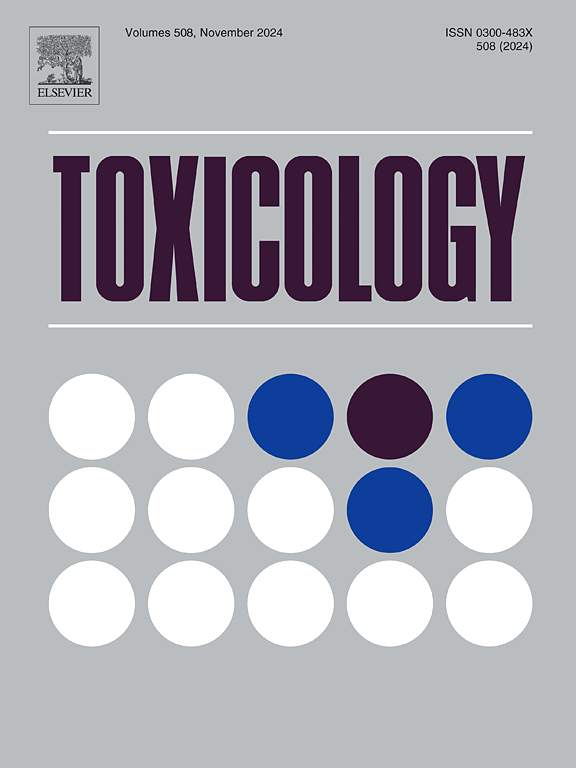二恶英样化合物对体外人造血分化的调控作用
IF 4.8
3区 医学
Q1 PHARMACOLOGY & PHARMACY
引用次数: 0
摘要
某些类二恶英化合物(dlc)会造成健康问题。然而,它们对人类造血的影响尚未被探索。研究了2,3,4,7,8-五氯二苯并呋烷(PeCDF)、3,4,4 ‘,5-四氯联苯(PCB81)和3,3 ’,4,4 ',5-五氯联苯(PCB126)在人脐带血来源的CD34+造血干细胞和祖细胞(HSPCs)谱系鉴定中的作用。我们比较了这些dlc与2,3,7,8-四氯二苯并-对二恶英(TCDD)的关系。在28天的时间里,在0.1至50 nM浓度范围内的TCDD和dlc存在下体外培养HSPCs。每7天收集一次细胞进行分析。TCDD、PeCDF、PCB-126和PCB-81以浓度依赖的方式降低CD10+淋巴样祖细胞的百分比和CD10蛋白的表达。PeCDF效价高于TCDD, PCB81效价高于PCB126。TCDD和PeCDF还在多个时间点诱导CD34表达细胞和CD1c+树突状细胞减少,早幼粒细胞增加。这些变化是通过芳烃受体(AHR)介导的。随着TCDD和PeCDF浓度的增加,CD41+巨核细胞祖细胞呈减少趋势,CD14+单核细胞呈增加趋势。该研究表明,这些dlc改变了人类HSPC向特定髓系造血谱系的分化过程,而牺牲了淋巴祖细胞,类似于TCDD,这可能导致免疫能力降低。确定了对dlc发育调节最敏感的谱系。有趣的是,这些dlc在人类中引发这些效应的相对效力与在小鼠研究中报告的化合物的相对毒理学特征不同,这对这些化合物的人类风险评估具有重要意义。本文章由计算机程序翻译,如有差异,请以英文原文为准。
Regulation of in vitro human hematopoietic differentiation by dioxin-like compounds
Certain dioxin-like compounds (DLCs) pose health concerns. However, their impact on human hematopoiesis has not been explored. Role of 2,3,4,7,8-pentachlorodibenzofuran (PeCDF), 3,4,4′,5-tetrachlorobiphenyl (PCB81), and 3,3′,4,4′,5-pentachlorobiphenyl (PCB126) in lineage specification from human cord-blood derived CD34+ hematopoietic stem and progenitor cells (HSPCs) was investigated. We compared these DLCs in relation to 2,3,7,8-tetrachlorodibenzo-p-dioxin (TCDD). Over a 28-day period, HSPCs were cultured in vitro in the presence of TCDD and DLCs at concentrations ranging from 0.1 to 50 nM. Cells were collected every 7 days for analysis. TCDD, PeCDF, PCB-126, and PCB-81 reduced percentage of CD10+ lymphoid progenitors and CD10 protein expression in a concentration-dependent manner. PeCDF was more potent than TCDD, and PCB81 had higher potency than PCB126. TCDD and PeCDF also induced reduction in CD34 expressing cells and CD1c+ dendritic cells, and an increase in promyelocytes at multiple time-points. These changes were mediated through the aryl hydrocarbon receptor (AHR). With increasing concentrations of TCDD and PeCDF, there was a trend towards decreases in CD41+ megakaryocyte progenitors and increases in CD14+ monocytes. This study demonstrated that these DLCs altered human HSPC differentiation process towards specific myeloid hematopoietic lineages at the expense of lymphoid progenitors, similar to TCDD, which may lead to reduced immune competence. Lineages that were most sensitive to developmental modulation by DLCs were identified. Interestingly, the relative potency of these DLCs in eliciting these effects in humans was different from the compounds’ relative toxicological profiles as reported in murine studies, with important implications for human risk assessment for these compounds.
求助全文
通过发布文献求助,成功后即可免费获取论文全文。
去求助
来源期刊

Toxicology
医学-毒理学
CiteScore
7.80
自引率
4.40%
发文量
222
审稿时长
23 days
期刊介绍:
Toxicology is an international, peer-reviewed journal that publishes only the highest quality original scientific research and critical reviews describing hypothesis-based investigations into mechanisms of toxicity associated with exposures to xenobiotic chemicals, particularly as it relates to human health. In this respect "mechanisms" is defined on both the macro (e.g. physiological, biological, kinetic, species, sex, etc.) and molecular (genomic, transcriptomic, metabolic, etc.) scale. Emphasis is placed on findings that identify novel hazards and that can be extrapolated to exposures and mechanisms that are relevant to estimating human risk. Toxicology also publishes brief communications, personal commentaries and opinion articles, as well as concise expert reviews on contemporary topics. All research and review articles published in Toxicology are subject to rigorous peer review. Authors are asked to contact the Editor-in-Chief prior to submitting review articles or commentaries for consideration for publication in Toxicology.
 求助内容:
求助内容: 应助结果提醒方式:
应助结果提醒方式:


